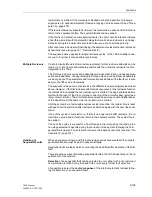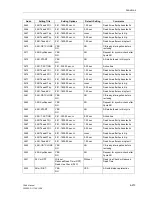
Functions
6-209
7SA6 Manual
C53000-G1176-C156-2
If there is a risk of stability problems in the network during a three-pole interruption,
the setting in address
3437
ADT SynRequest
should be
Yes
. In this case the voltage
of the line and busbar are checked after a three pole trip and before reclosure to de-
termine if sufficient synchronism exists. This assumes that the device has a voltage
and synchronism check capability or that an external device is available for this pur-
pose. If only single-pole reclosure cycles are executed or no stability problems are ex-
pected during three-pole dead times (e.g. due to close meshing of the network or in
radial networks), set address
3437
to
No
.
Addresses
3438
and
3440
are only significant if the voltage-controlled adaptive dead
time is used. Set under address
3440
U-live>
the limit voltage phase–earth above
which the line is considered to be fault-free. The setting must be smalIer than the low-
est expected operating voltage. The setting is applied in Volts secondary. This value
can be entered as a primary value when parametrizing with a PC and DIGSI
®
4. Ad-
dress
3438
T U-stable
determines the measuring time used to determine that the
line is fault free with this return voltage. It should be longer than any transient oscilla-
tions resulting from line energization.
1st Reclosure Cy-
cle
If working on a line with adaptive dead time, no further parameters are needed for the
individual reclose cycles here. All the following parameters assigned to the individual
cycles are then superfluous and inaccessible.
Address
3450
1.AR: START
is only available if the automatic reclosure is configured
with action time in the operating mode, i. e. if address
134
AR control mode
=
Pickup w/ Tact
or
Trip w/ Tact
was set when configuring the protection func-
tions (the first setting only applies to three-pole tripping). It determines whether auto-
matic reclosure should be started at all with the first cycle. This address is included
mainly for the sake of uniformity of the parameters for all the reclosure cycles and must
be set to
Yes
for the first cycle. If several cycles are used it is possible to control (in
control mode with PICKUP) the effect of the individual cycles with this parameter and
various action times. Notes and examples can be found in section 6.14.1 under subti-
tle “Action Times” (page 190).
The action time
1.AR: T-ACTION
(address) is the time after pickup (fault detection)
by any protective function which can start the automatic reclosure function within
which the trip command must appear. If the command does not appear until after the
action time has expired, there is no reclosure. Depending on the configuration of the
protective functions (see section 5.1) the action time may also be omitted; this applies
especially when an initiating protective function has no fault detection signal.
Depending on the configured operating mode of the automatic reclosure (see section
5.1 under address
134
AR control mode
) only addresses
3456
and
3457
(if con-
trol mode
with TRIP
) or the addresses
3453
to
3455
(if operating mode with PICK-
UP
) are available.
In the control mode
with TRIP
it is possible to set different dead times for single-pole
and three-pole reclose cycles. Whether single-pole or three-pole tripping takes place
depends solely on the initiating protection functions. Single-pole tripping is only possi-
ble of course if the device and the corresponding protection function are also capable
of single-pole tripping.
Address
3456
1.AR Tdead1Trip
is the dead time after 1-pole tripping,
Address
3457
1.AR Tdead3Trip
is the dead time after 3-pole tripping.
If only single-pole reclose cycle are to be allowed, the dead time for three-pole tripping
must be set to
∞
. If only three-pole reclose cycle are to be allowed, the dead time for
single-pole tripping must be set to
∞
; the protection then trips three-pole for all fault
types.
Summary of Contents for siprotec 7SA6
Page 2: ...Siemens Aktiengesellschaft Book No C53000 G1176 C156 2 ...
Page 18: ...xviii 7SA6 Manual C53000 G1176 C156 2 ...
Page 32: ...Introduction 1 14 7SA6 Manual C53000 G1176 C156 2 ...
Page 82: ...Hardware and Connections 2 50 7SA6 Manual C53000 G1176 C156 2 ...
Page 119: ...SIPROTEC 4 Devices 4 25 7SA6 Manual C53000 G1176 C156 2 Figure 4 20 CFC Logic example ...
Page 190: ...Configuration 5 62 7SA6 Manual C53000 G1176 C156 2 ...
Page 652: ...Installation and Commissioning 8 78 7SA6 Manual C53000 G1176 C156 2 ...
Page 724: ...Technical Data 10 56 7SA6 Manual C53000 G1176 C156 ...
Page 800: ...Appendix A 76 7SA6 Manual C53000 G1176 C156 2 ...
Page 866: ...Appendix B 66 7SA6 Manual C53000 G1176 C156 2 ...











































